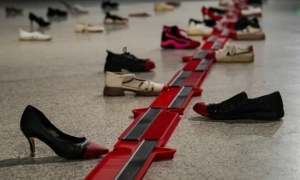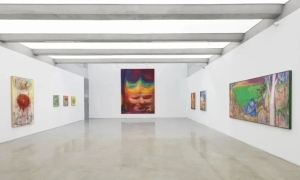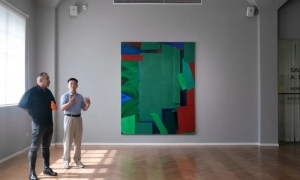曾健勇的错位生灵
文:Carol Cheh
曾健勇的近作「大队长」系列描绘的是中国的学校班级里的顶尖学生,他们不但成绩优秀,而且能够尊重师长,团结同学。大队长意味着在各方面都出类拔萃,是中国小孩向往的荣誉。同时,这一头衔受到的重视体现出孩子们所肩负的文化压力。这些压力除了有学习方面的,还有社会环境方面的,在某些情况下,它们会对孩子形成压迫与伤害。在最极端的例子里,这种压力会导致抑郁症甚至自杀行为。
在曾健勇的画里可以看到日常装束的小孩(一个或多个)被置于空白、中性的背景之上。他们手臂上带有三道杠的袖章以及胸前醒目的黑色领巾揭示了他们的大队长身份。曾健勇意不在写实,而是带有象征和讽刺的意味。尽管通过努力分辨可以看出那些小孩之间的区别,但他们都有着同样的标签式外貌:皮肤上疑似血迹的红斑,过大的头部,小巧的口鼻,以及令人惊异的仿佛破裂的大理石般的银灰色眼睛。
画家玛格丽特•奇恩的那些大眼睛小孩在一九六零年代成为美国大众文化的重要现象。和奇恩一样,曾建勇在这批作品里以眼睛为焦点,为画中人物提供了张力,并为观者提供了可玩味的元素。透过看这些小孩的眼睛,我们也看到了他们所看到的事物以及我们自身。不过,奇恩笔下那些大而清澈的眼睛似乎包容了整个世界,而曾健勇画中孩子们的目力似乎受到了他们那玻璃般的眼睛的限制。那些眼睛像是某次创伤之后的产物,令这些孩子永远只能偏狭地观看这个世界。观画者不禁要想:究竟出了什么问题?这些作品里的破碎感似乎来自那破碎的眼睛,而在眼睛周围是一块块仿似血脉般的痕迹,遍布孩子们的脸和手臂。
曾健勇曾说,作为艺术家,他「珍视人类本性中的弱点,如非理性和脆弱」,并试图在作品中面对这些特质。「大队长」系列的灵感部分来自于他年幼的儿子。儿子在小学里的经历与画家自己的不谋而合。从风格上讲,曾健勇说自己的影响主要来自西方当代艺术。除奇恩之外,他的作品还会让人联想到丽莎•于斯卡维治、约翰•卡灵或伊贡•席尔等人笔下那如吸毒者一般的扭曲人像。同时,你还可以在其中看到奥诺黑•多米埃和乔治•格罗兹等社会批判主义者的影子。曾本人表示,意大利静物画家乔吉奥•莫兰迪那简单低回的风格以及用色都对他有着长期影响。
曾健勇使用的材料与中国传统水墨画有关:手工制作的纸、墨以及矿物质颜料。然而在「大队长」系列以及「闲着」系列中用到的技巧则是他自己的。这一系列中的每张画都要用到两张纸,曾把一张贴到画板上,在另外一张上作画,待颜色干后,再把它贴附到画板上。如此一来,颜色就夹在了两张纸的中间。由于所采用的纸具有类似米纸般的半透明效果,观者可以透过纸张看到画面。用这种方法制成的画有一种褪色的荧光效果--遥远而又迫近。虽然图像略显模糊,但其张力仍然穿透纸面,呼之欲出。有时为了加强这一效果,画家还会在纸面上添补几笔。
曾健勇的作品之所以独特而引人入胜,其原因是多方面的,其中有东西方两面的训练和影响。用艺术家自己的话说:「如果觉得我的作品融合了东西方艺术风格,我想,这是一个很自然的结果。我在学生时期同时接受东西方绘画训练,即关注东方艺术的历史,也关注西方艺术的发展。后来又有很多创作经历:中国画,油画,版画,绘本图书及多媒体及三维动画等等。这些经历已经使我不用去衡量东西方风格问题了。可能可以用很多的文字来分析我的创作中的东西方元素,也可能我的创作本来就不是东方的,也不是西方的。各种各样的推理和逻辑背后,我还是依顺自己的直觉。」
(Carol Cheh,作家、策展人,现居洛杉矶。)
ZENG JIANYONG’S DISPLACED CREATURES
Carol Cheh
The Header series, a recent group of paintings by Zeng Jianyong, refers to a term used in the People’s Republic of China to denote the head of the class—the top pupil, a child who not only earns good grades, but respects his or her elders and gets along well with others. The “header,” held up as an example of all-around excellence, is something that Chinese children eagerly aspire to be. At the same time, the existence of this lauded position highlights how much cultural pressure there is to excel in both scholastic and social environments—pressure that can at times become harmful and oppressive. In more extreme cases, this pressure has led to depression and even suicide.
Zeng’s paintings depict a single child or group of children in ordinary dress against an empty, neutral background. An armband bearing three horizontal stripes and a prominent black scarf worn about the shoulders identifies the header. Intended as emblems or caricatures rather than realistic portraits, Zeng’s children, while discernible from one another, all have a certain trademark look—ruddy marks on their skin that could be blood stains, overly large heads, tiny noses and mouths, and startling silver-grey eyes that look like shattered marbles.
Like Margaret Keane, whose paintings of big-eyed children became an American pop-culture phenomenon in the 1960s, Zeng uses his children’s remarkable eyes to fix both the viewer and the subject, providing a focal point for tension and interaction. We look into the children’s eyes to see what they see, and to see ourselves reflected. Unlike Keane’s children, however, whose eyes are so large and clear that they seem to take the whole world in at once, Zeng’s children seem to be saddled with malfunctioning glass eyes, perhaps introduced into their bodies following some kind of trauma, and now dooming them to forever see the world in a skewed fashion. One wonders, what went wrong here? The splintered eyes seem to be the origin for an entirely splintered sensibility, which reveals itself in the bloody vein-like markings spreading across the children’s faces and arms.
Zeng has said that as an artist, he “treasures the weaknesses of human nature, such as irrationality and fragility,” and tries to tap into these qualities when making his art. The Header series was partially inspired by Zeng’s young son, whose current experiences in primary school are reminding the artist of his own upbringing. Stylistically, Zeng cites the influence of Western contemporary sources. In addition to Keane, his work can be linked to the whacked-out portraiture of Lisa Yuskavage, John Currin, or Egon Schiele. It also has something in common with the social criticisms of Honoré Daumier and George Grosz. Zeng himself cites the simplicity and modest charms, and perhaps the color palette, of Italian still-life painter Giorgio Morandi as an abiding influence.
Zeng uses materials that are associated with traditional Chinese painting and watercolor—handmade paper, inks, and watercolors. However, the technique that he employs in the Header series, as well as in the Spare Time series (discussed later in this book), is his own. Using two sheets of handmade paper, Zeng adheres one sheet to a board, then takes the second sheet and paints the image on the surface. Once the image is dry, he flips it over and adheres it to the first sheet on the board. then takes the second sheet and paints the image on the surface. Once the image is dry, he flips it over and adheres it to the first sheet on the board. Thus, the image is sandwiched between the two sheets, which have the delicate translucence of rice paper, and the viewer sees the image through the paper. The result is that the paintings have a luminously faded look—a look of faraway urgency. While there is a mild obscuring of the image, its intensity still shimmers through, sometimes accented by extra layers of ink added to the top surface.
Zeng’s unique and absorbing work is the product of a wide variety of influences and training, both Eastern and Western. In the artist’s own words, “If my art is considered a mix of Eastern and Western styles, I prefer to view it as a natural result. During my student time of artistic training, I had training in both Chinese and Western art skills, and I studied the histories of both. I have tried many different methods, such as Chinese traditional painting, oil painting, printmaking, illustration, mixed media, and 3D animation. All these experiences naturally improved my style. It is possible to elaborate on the Eastern elements and Western elements in my art, or, to deny that my art belongs to any style. I always follow my intuitions.”
Carol Cheh is a writer and curator based in Los Angeles.
【编辑:贾娴静】






















